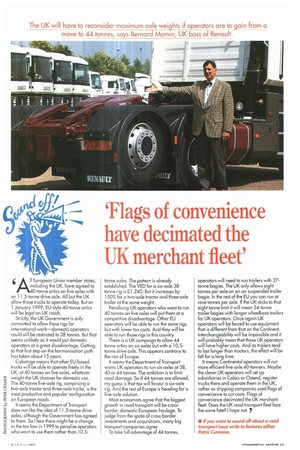'Flags of convenience have decimated the UK merchant fleet'
Page 53

If you've noticed an error in this article please click here to report it so we can fix it.
4 ll European Union member states, AA including the UK, have agreed to 0-tonne artics on five axles with an 11.5-tonne drive axle. All but the UK allow those trucks to operate today. But on 1 January 1999, EU-style 40-tonne artics will be legal on UK roads.
Strictly, the UK Government is only committed to allow these rigs for international work—domestic operators could still be restricted to 38 tonnes. But that seems unlikely as it would put domestic operators at a great disadvantage. Getting to that first step on the harmonisation path has taken about 15 years. Cabotage means that other EU-based trucks w]ll be able to operate freely in the UK, at 40 tonnes on five axles, whatever weight the UK chooses for domestic use. The 40-tonne five-axle rig, comprising a two-axle tractor and three-axle trailer, is the
Lth,' most productive and popular configuration
0_ on European roads.
-8It seems the Department of Transport does not like the idea of 11.5-tonne drive 1 axles, although the Government has agreed 8 to them. So I Fear there might be a change b in the tax law in 1999 to penalise operators 1 who want to use them rather than 10.5
tonne axles. The pattern is already established. The VED for a six-axle 38tonne rig is £1,240. But it increases by 150% for a Iwo-axle tractor and three-axle trailer at the same weight. Penalising UK operators who want to run 40 tonnes on five axles will put them at a competitive disadvantage. Other EU operators will be able to run the same rigs but with lower tax costs. And they will be able to run those rigs in this country. There is a UK campaign to allow 44 tonne artics on six axles but with a 10.5tonne drive axle. This appears contrary to the rest of Europe. It seems the Department of Transport wants UK operators to run six axles at 38, 40 or 44 tonnes. The ambition is to limit road damage. So if 44 tonnes are allowed, my guess is that tax will favour a six-axle rig. And the rest of Europe is heading for a five-axle solution.
Most economists agree that the biggest growth in road transport will be crossborder, domestic European haulage. To judge from the spate of cross-border investments and acquisitions, many big transport companies agree. To take full advantage of 44 tonnes,
operators will need to run trailers with 27tonne bogies. The UK only allows eight tonnes per axle on an air suspended trailer bogie. In the rest of the EU you can run at nine tonnes per axle. If the UK sticks to that eight tonne limit it will mean 24-tonne trailer bogies with longer wheelbase trailers for UK operators. Once again UK operators will be forced to use equipment that is different from that on the Continent. Interchangeability will be impossible and it will probe ly mean that those UK operators will have higher costs. And as trailers tend to last longer than tractors, the effect will be felt for a long time.
It means Continental operators will run more efficient five-axle 40-tanners. Maybe the clever UK operators will set up subsidiaries in Calais or Ostend, register trucks there and operate them in the UK, rather as shipping companies used flags of convenience to cut costs. Flags of convenience decimated the UK merchant fleet. Does the UK road transport fleet face the same fate? I hope not.
• if you want to sound off about a road transport issue write to features editor Pa Irk Cunnone.






































































































